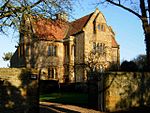Blisworth
Civil parishes in NorthamptonshireCountry houses in NorthamptonshireHistory of NorthamptonshireTourist attractions in NorthamptonshireUse British English from March 2014 ... and 2 more
Villages in NorthamptonshireWest Northamptonshire District

Blisworth is a village and civil parish in the West Northamptonshire, England. The West Coast Main Line, from London Euston to Manchester and Scotland, runs alongside the village partly hidden and partly on an embankment. The Grand Union Canal passes through the village and the north portal of the Blisworth tunnel is near Stoke Road.The village's name means 'Blith's enclosure'.
Excerpt from the Wikipedia article Blisworth (License: CC BY-SA 3.0, Authors, Images).Blisworth
Courteenhall Road,
Geographical coordinates (GPS) Address Phone number Website Nearby Places Show on map
Geographical coordinates (GPS)
| Latitude | Longitude |
|---|---|
| N 52.175 ° | E -0.937 ° |
Address
Blisworth Community Primary School
Courteenhall Road
NN7 3DD
England, United Kingdom
Open on Google Maps










